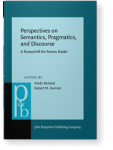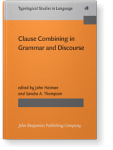Johan van der Auwera
List of John Benjamins publications for which Johan van der Auwera plays a role.
Yearbook
Journal
ISSN 1874-8767 | E-ISSN 1874-8775
Postverbal negation
Edited by Olga Krasnoukhova, Johan van der Auwera and Mily Crevels
Special issue of Studies in Language 45:3 (2021) v, 208 pp.
Subjects Functional linguistics | Theoretical linguistics | Typology
Modal Verbs in Germanic and Romance Languages
Edited by Johan van der Auwera and Patrick Dendale
[Belgian Journal of Linguistics, 14] 2000. vi, 264 pp.
Subjects Germanic linguistics | Romance linguistics | Semantics | Syntax
Universals of Language
Edited by Michel Kefer and Johan van der Auwera
[Belgian Journal of Linguistics, 4] 1989. 192 pp.
Subjects Theoretical linguistics
Language and Logic: A speculative and condition-theoretic study
Johan van der Auwera
[Pragmatics & Beyond Companion Series, 2] 1985. xiv, 256 pp.
Subjects Cognition and language | Philosophy | Pragmatics | Semantics
What Do We Talk About When We Talk?: Speculative grammar and the semantics and pragmatics of focus
Johan van der Auwera
[Pragmatics & Beyond, II:3] 1981. vi, 122 pp.
Subjects Pragmatics | Semantics
2021 Postverbal negation: Typology, diachrony, areality Postverbal negation, Krasnoukhova, Olga, Johan van der Auwera and Mily Crevels (eds.), pp. 499–519 | Introduction
The paper sketches the state of affairs of our understanding of postverbal negation. It departs from the typological finding that there is a cross-linguistic preference for a negator to precede the verb. Nevertheless, a sizable proportion of the world’s languages adhere to a pattern with a… read more
2019 Negation in Kulina: A double polarity swap Journal of Historical Linguistics 9:2, pp. 208–238 | Article
This study reconstructs the development of a negative existential and a negative pro-sentence in the Arawan language Kulina (Brazil-Peru). We demonstrate that the two elements forming the negative existential construction nowe (hi)ra- are involved in a double polarity swap: (i) an originally… read more
2017 Englishes, English creoles and their negative indefinites Negation and Contact: With special focus on Singapore English, Ziegeler, Debra and Zhiming Bao (eds.), pp. 115–149 | Article
This is a typological study of negative indefinites, i.e., the counterparts to standard English nobody and nothing, in Englishes, primarily the New Englishes, and in English Creoles. Particular attention goes to “Negative Concord” (“NC”), i.e. the exponence of negation through both a negative… read more
2017 Kiranti double negation: A copula conjecture Linguistics of the Tibeto-Burman Area 40:1, pp. 40–58 | Article
It is shown how Kiranti languages often express a semantically single clausal negation of a declarative verbal main clause with two clausal negators. We conjecture that the second negator has its origin in a copula and that the reinterpretation and integration of the copula into a negative… read more
2016 Jespersen cycles in the Mayan, Quechuan and Maipurean languages* Cyclical Change Continued, Gelderen, Elly van (ed.), pp. 189–218 | Article
This study looks for evidence for the Jespersen Cycle, which is typically the development from one single negator to another one via a strengthening stage in which both are present, in the Mayan, Quechuan and Maipurean languages. For Mayan and Quechuan languages the evidence is solid, and what is… read more
2016 On the typology of negative concord Studies in Language 40:3, pp. 473–512 | Article
This paper has three main points. First, contrary to what is often stated, negative concord is not all that frequent and certainly not the most frequent strategy to express single clausal negation in a clause with an indefinite noun phrase or adverbial in the scope of the negation. Second, the… read more
2015 Indefinite pronouns in Uralic languages Negation in Uralic Languages, Miestamo, Matti, Anne Tamm and Beáta Wagner-Nagy (eds.), pp. 519–546 | Article
In this paper, different types of indefinite pronouns and adverbs that can occur in negative sentences in the Uralic languages will be described and discussed against a wider typological background. It will be shown that Uralic languages display the typological default strategy as to the… read more
2015 Recent quantitative changes in the use of modals and quasi-modals in the Hong Kong, British and American printed press: Exploring the potential of Factiva® for the diachronic investigation of World Englishes Grammatical Change in English World-Wide, Collins, Peter (ed.), pp. 437–464 | Article
This chapter uses Factiva® to examine recent evolution in the occurrence of verbal modal expressions in the Hong Kong newspaper South China Morning Post, in contrast with American and British newspapers. Previous research established that the frequency of the modals is decreasing in both British… read more
2014 On the relation between double clausal negation and negative concord The Diachrony of Negation, Mosegaard Hansen, Maj-Britt and Jacqueline Visconti (eds.), pp. 13–46 | Article
Negative concord and double clausal negation are separate phenomena, which show some striking similarities, the main similarity being the fact that negation is formally expressed more than once, but semantically only once. These similarities have led scholars to hypothesize on whether and how these… read more
2014 The Jespersen cycles seen from Austronesian The Diachrony of Negation, Mosegaard Hansen, Maj-Britt and Jacqueline Visconti (eds.), pp. 47–82 | Article
Most work on the so-called ‘Jespersen Cycle’ has been done on the languages of Europe, less on languages of Africa. In this paper the authors look at Austronesian languages, with the aim to determine to what extent Austronesian doubling is compatible with a Jespersen cycle scenario. The properties… read more
2013 Semantic maps, for synchronic and diachronic typology Synchrony and Diachrony: A dynamic interface, Giacalone Ramat, Anna, Caterina Mauri and Piera Molinelli (eds.), pp. 153–176 | Article
This paper presents classical maps as accounts of both the synchronic polysemy of constructions and of their gradual semantic developments. This presentation is set against the background of a critique of the usefulness of classical semantic maps, voiced by the proponents of a newer kind of map, a… read more
2013 Chapter 6. Scalar additive operators in Transeurasian languages: A comparison with Europe Shared Grammaticalization: With special focus on the Transeurasian languages, Robbeets, Martine and Hubert Cuyckens (eds.), pp. 113–146 | Chapter
This article provides a survey of scalar additive operators such as Turkish bile, Japanese sae, Korean cocha ‘even’, etc. and related expressions in a sample of thirteen Transeurasian languages. The data is presented and interpreted against the background of evidence from European languages and… read more
2012 From contrastive linguistics to linguistic typology Contrastive Linguistics and other Approaches to Language Comparison, Hüning, Matthias and Barbara Schlücker (eds.), pp. 69–86 | Article
The paper looks back at Hawkins (1986), A comparative typology of English and German, and shows, on the basis of raising and human impersonal pronouns in English, Dutch and German, that contrastive linguistics can be viewed as a pilot study in typology. It also pleads for doing the contrastive… read more
2012 The diverging need (to)’s of Asian Englishes Mapping Unity and Diversity World-Wide: Corpus-Based Studies of New Englishes, Hundt, Marianne and Ulrike Gut (eds.), pp. 55–76 | Article
This paper proffers a corpus-based study of the modal auxiliary need and its lexical counterpart need to in four Asian varieties of English, viz. Hong Kong, Singapore, Philippine and Indian English, in comparison to British and American English. We investigate the distribution of need and need to… read more
2012 Human impersonal pronouns in Swedish and Dutch: A contrastive study of man and men Languages in Contrast 12:2, pp. 121–138 | Article
This paper presents a contrastive study of the human impersonal pronouns man in Swedish and men in Dutch. Both impersonal pronouns are etymologically derived from man ‘human being’ and they more or less have the same meaning. However, there are important differences in the usage of these pronouns.… read more
2009 Chapter 3. The Jespersen cycles Cyclical Change, Gelderen, Elly van (ed.), pp. 35–72 | Article
2009 Acquisitive modals Cross-linguistic Semantics of Tense, Aspect, and Modality, Hogeweg, Lotte, Helen de Hoop and Andrej L. Malchukov (eds.), pp. 271–302 | Article
The paper explores the fact that ‘get’ etymons may acquire modal meanings. It tries to fit this fact into the modal map proposal of van der Auwera & Plungian (1998) and concludes that the map has to be revised, in part because the lexical input, the predicates meaning ‘get/acquire’ allow more than… read more
2008 (Tense), aspect, mood and modality – an imperfect 2008 state of the art report Unity and Diversity of Languages, Sterkenburg, Piet van (ed.), pp. 201–214 | Article
2007 Double negation and iconicity Insistent Images, Tabakowska, Elżbieta, Christina Ljungberg and Olga Fischer (eds.), pp. 301–320 | Article
Typological research suggests that double negation - the use of two negative markers to denote one negative meaning - is a popular strategy amongst a wide variety of languages. This paper focuses on two types of double negation. The first type, exemplified by Fr. Je ne chante pas ‘I don’t sing’,… read more
2006 Negative indefinites: A typological and diachronic perspective on a Brabantic construction Types of Variation: Diachronic, dialectal and typological interfaces, Nevalainen, Terttu, Juhani Klemola and Mikko Laitinen (eds.), pp. 305–319 | Article
2004 From optative and subjunctive to irrealis Seduction, Community, Speech: A Festschrift for Herman Parret, Brisard, Frank, Michael Meeuwis and Bart Vandenabeele (eds.), pp. 87–96 | Chapter
2004 On Judeo-Spanish conditionals Balkan Syntax and Semantics, Mišeska Tomić, Olga (ed.), pp. 461–474 | Article
2002 More thoughts on degrammaticalization New Reflections on Grammaticalization, Wischer, Ilse and Gabriele Diewald (eds.), pp. 19–29 | Article
2001 On the typology of negative modals Perspectives on Negation and Polarity Items, Hoeksema, Jack, Hotze Rullmann, Víctor Sánchez-Valencia and Ton van der Wouden (eds.), pp. 23–48 | Article
2001 On the lexical typology of modals, quantifiers, and connectives Perspectives on Semantics, Pragmatics, and Discourse: A Festschrift for Ferenc Kiefer, Kenesei, István and Robert M. Harnish (eds.), pp. 173–186 | Article
2000 Introduction Modal Verbs in Germanic and Romance Languages, Auwera, Johan van der and Patrick Dendale (eds.), pp. v–vi | Miscellaneous
1999 Dutch Verbal Prefixes: Meaning and form, grammaticalization and lexicalization Boundaries of Morphology and Syntax, Mereu, Lunella (ed.), pp. 121–136 | Article
1997 Conditional perfection On Conditionals Again, Athanasiadou, Angeliki and René Dirven † (eds.), pp. 169–190 | Article
1992 Free Relatives Layered Structure and Reference in a Functional Perspective: Papers from the Functional Grammar Conference, Copenhagen, 1990, Fortescue, Michael, Peter Harder and Lars Kristoffersen (eds.), pp. 329–354 | Article
1989 Introduction Universals of Language, Kefer, Michel and Johan van der Auwera (eds.), pp. 7–8 | Miscellaneous
1988 Clause integration in German and Dutch conditionals, concessive conditionals, and concessives Clause Combining in Grammar and Discourse, Haiman, John and Sandra A. Thompson (eds.), pp. 101–134 | Article
1983 On the Relativization of Embedded Subjects Studies in Language 7:2, pp. 277–281 | Miscellaneous
1983 Review of Pollock (1982): Language and Thought Studies in Language 7:3, pp. 451–454 | Review
1982 Extraposition and Permutation in Portuguese Lingvisticæ Investigationes 6:2, pp. 403–404 | Discussion







































